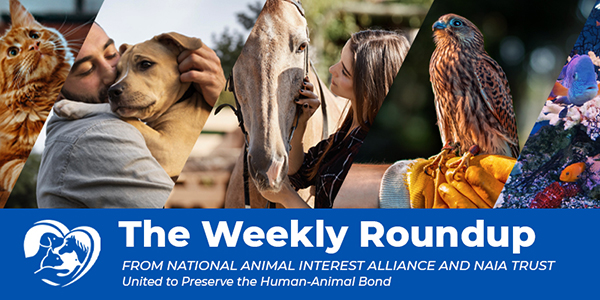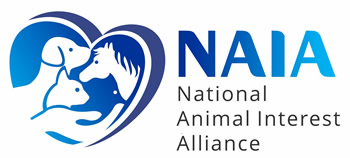
Inside This Issue:
- Owner Surrenders and Reducing Your Chances of Becoming a Statistic
- Do Migratory Animals Navigate with the Help of Bacteria?
- That'll Do: Study on Attachment Compares Pigs and Dogs
- Yosemite Meadow Says Hello (Once Again) to Its Favorite Toad
- French Bulldog Breeder Charged After Leaving Puppies in Hot Vehicle
Owner Surrenders and Reducing Your Chances of Becoming a Statistic

Here comes trouble.
An article on the crisis of owner surrenders hitting New York City shelters does an excellent job of laying out the problem faced by the city’s shelters. Like many parts of the country, the city's shelters and rescues have reported a great “flip.” In 2020, during the COVID-19 pandemic, many shelters throughout the United States were practically emptied out by people seeking pets. While there was some predictable tut-tutting from the usual suspects, these “pandemic pets” were one of the few silver linings of the pandemic, and there is no compelling evidence that pandemic pet owners began dumping their dogs and cats in shelters once their pet’s novelty wore off.
However, by 2022, something had clearly changed. Shelters, some that had been nearly empty only two years prior, began signaling the alarm that they were becoming dangerously full again. Owner surrenders were a huge part of this, and the reason for these surrenders weren’t because people had grown bored or annoyed with their COVID companions. Time and time again, the surrenders were tied to a heartbreaking economic pragmatism: with the rising cost of living, people just couldn’t afford to keep their pets. Pet owners couldn’t afford food and pet supplies. They couldn’t afford (or even find) veterinary care. They were forced to move into less expensive rentals with a “no pets” policy.
And of course, economic woes don’t just mean owner surrenders. Concerns over finances and housing also make people less likely to take on new responsibilities in pet ownership. This means fewer adoptions. It also has a less-talked-about, but incredibly sad side effect of making animals in shelters less appealing to adopters. Longer stays, especially in places that lack enough staff and space to properly care for the dogs and cats on hand, contribute to behavioral issues and other problems that prevent a pet from putting its best face forward to the public.
So, we’ve identified several problems, which is a necessary task, even though it may be depressing. Knowledge can provide a roadmap to more adoptions and better outcomes, after all. But in the meanwhile, while everyone fights like cats and dogs (sorry) over which end of this roadmap points north, what should current pet-seekers do to reduce their chances of becoming an owner-surrender statistic? Aside from the obvious prep work – research, budgeting, and creating realistic expectations – we have one additional controversial suggestion. Don’t be afraid to select puppies and kittens. Young animals are a handful, but there are benefits that come with being there to provide training and guidance during your pet’s critical development periods.
Do Migratory Animals Navigate with the Help of Bacteria?

Not crying. Just excreting salt!
Many animals use the Earth’s magnetic field as a compass, a phenomenon known as magnetoreception. The mechanism for this works in a couple of ways. For example, animals can have magnetite metal in their bodies, or they can use a light sensitive protein called cryptochrome. Now, researchers may have found an additional tool that helps animals tune into the Earth’s magnetic field: magnetic bacteria.
These bacteria, more formally known as magnetotactic bacteria (MTB), produce magnetic iron crystals. The atoms of iron in these biocrystals align with the Earth’s magnetic poles in the exact same way iron in magmas do. That alignment acts as a compass and provides a sense of direction for their travels.
UCF Department of Biology Assistant Professor Robert Fitak has taken the signature of the MTB and applied it to animals that use long distance navigation for migration. He and his team are studying whether the bacteria actually gives these animals a heightened sensitivity to the Earth’s magnetic field.
At this time, it is not conclusive that the bacteria’s iron biocrystals are doing just that, but given that they are present in the bodies of numerous migratory animals it’s definitely interesting. Fitak and his team are focusing their research on green and loggerhead sea turtles because they contain MTB and reliably use the Earth’s magnetic field to accurately return to places all over the world. They are collecting the DNA from sea turtle tears to help conclude whether or not the turtles are using the biosynthesized iron as a navigational tool. Since the research is still in its infancy, Fitak and his team are just excited to share the news about bacteria making magnets and how unique that is in and of itself.
That'll Do: Study on Attachment Compares Pigs and Dogs

Domesticated, but perhaps not so attached.
The findings in a new study on the attachment bond of pigs vs. dogs suggest something we all kinda knew on a gut level: dogs got it, pigs don’t. In ethological terms, “attachment” refers to dependency – like a child depending on her mom. When your dog checks in with you in unfamiliar situations, behaves differently toward you than a stranger, or greets you excitedly (perhaps anxiously) after being separated from you, that’s an example of attachment.
In the study’s test, the behaviors of dogs and highly socialized companion pigs were observed as their owner and a stranger entered and left a room, sometimes engaging in activities like sitting down or playing a game. Unlike dogs, the pigs (no doubt lovely pets in their own way) did not demonstrate behaviors associated with the attachment bond. Pigs, like dogs, have been domesticated and are highly social animals. But the findings here suggest something much deeper: that no matter how domesticated the pig is, no matter how intensely socialized, there is an element of selective breeding for attachment in dogs that has not happened with pigs.
Yosemite Meadow Says Hello (Once Again) to Its Favorite Toad

Female Yosemite toad. Image: Maierpa, CC BY-SA 4.0, via Wikimedia Commons
Yosemite National Park, located in California's Sierra Nevada mountains, is renowned for its diverse ecosystems and stunning natural beauty, including towering granite cliffs, waterfalls, and giant sequoias. Yosemite is also known for its biodiversity, boasting numerous plant and animal species. In the past, conservationists successfully reintroduced a subspecies of bighorn sheep, the majority of which had died out over a century ago from a pneumonia outbreak and overhunting. Today, building on that success, Yosemite is celebrating another species reintroduction into their 750,000 acres of different landscapes: the Yosemite toad.
Unique to that one ecosystem, the Yosemite toad can live in high elevations and is only found in the Sierra Nevada mountains. The reintroduction of species into their former habitats is an important conservation strategy aimed at restoring ecosystems and preserving biodiversity. Because reintroduction is a complex process that requires careful planning, scientific research, and community involvement, the San Francisco Zoo and wildlife specialists at Yosemite worked together to rear and reintroduce the rare Yosemite toad. These toads have not been seen in about a decade since a disastrous wildfire wiped them out.
The San Francisco Zoo makes it a priority to focus on native California wildlife conservation so they were eager to help breed and raise toads for the project. Last week 118 toads were flown from the zoo to Yosemite and released into that same meadow with the hopes that in five years time, there will be a sustainable population. Increasing original biodiversity is a key goal in modern conservation projects. Amphibians, in general, are an important indicator species, highlighting the overall health of ecosystems. Toads, specifically, are important for maintaining pest populations, soil health and nutrient cycling, and provide a food source for predators. Researchers are looking forward to how this toadally awesome reintroduction will change Yosemite for the better in the long run.
French Bulldog Breeder Charged After Leaving Puppies in Hot Vehicle
A North Carolina French bulldog breeder has been charged with 7 counts of misdemeanor animal cruelty after leaving seven six-week-old puppies in a car on a 100-degree day. Police were called by concerned bystanders, who said the puppies had been in the vehicle for as long as 45 minutes. Yikes! After being taken from the vehicle, three of the puppies needed treatment in an oxygen chamber. Sadly, one of the puppies did not respond to treatment and was euthanized.
The breeder’s account of the situation differs from witnesses and police. In an interview, she said she had the car running, windows down, and a fan keeping the puppies cool. She insisted that she “is not an animal abuser.” But even if her account is accurate, it doesn’t exactly bolster her case; it’s not like rolling the windows down is going to be much help in that kind of heat (plus, it’d be just that much easier to steal the puppies). And even if there was no malicious intent behind leaving puppies in the vehicle, it should be painfully obvious that this was an incredibly dangerous choice.
It's hot out there, folks. Please be mindful and use common sense: one of the most tragic aspects of “hot car, dead dog” stories is how utterly avoidable they are.
Also in the News...
★ Meat from cloned animals sparks debate (Canada; Agricultural Regulations & Reporting)
★ The Surprising Role of Animals in Disease Detection (Dogs, Mice, and Ants; Do They Pass the Sniff Test?)
★ Bats can ramp up their heart rate to 900 beats per minute (Bat-Biology; Wildlife Energy & Conservation)
★ Washington County Controller April Sloane has bail revoked and reset in animal cruelty case (Neglect & Cruelty)
★ Meet the Taxidermists Who Care for the Animals at Your Favorite Museums (Wildlife Preservation in the Most Literal Sense)
★ Animal experiments shed more light on behavior of H5N1 from dairy cows (New Research; The Spread of Avian Flu)
★ The 13 Deadliest Animals In Oklahoma (Unluckily Numbered Goofy Lists; More Dangerous than Deadly)
Click here to see what is happening legislatively


